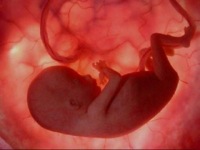Difference between revisions of "Gestation"
From Nordan Symposia
Jump to navigationJump to search (Created page with 'File:lighterstill.jpgright|frame ==Origin== Latin ''gestation''-, ''gestatio'', from ''gestare'' to bear, frequentative of ''gerere'' to bear *[ht...') |
m (Text replacement - "http://" to "https://") |
||
| Line 3: | Line 3: | ||
==Origin== | ==Origin== | ||
[[Latin]] ''gestation''-, ''gestatio'', from ''gestare'' to bear, frequentative of ''gerere'' to bear | [[Latin]] ''gestation''-, ''gestatio'', from ''gestare'' to bear, frequentative of ''gerere'' to bear | ||
| − | *[ | + | *[https://en.wikipedia.org/wiki/17th_century 1615] |
==Definitions== | ==Definitions== | ||
*1: the carrying of young in the uterus : [[pregnancy]] | *1: the carrying of young in the uterus : [[pregnancy]] | ||
*2: [[conception]] and [[development]] especially in the [[mind]] | *2: [[conception]] and [[development]] especially in the [[mind]] | ||
==Description== | ==Description== | ||
| − | '''Gestation''' is the carrying of an [[embryo]] or [[fetus]] inside [[female]] [ | + | '''Gestation''' is the carrying of an [[embryo]] or [[fetus]] inside [[female]] [https://en.wikipedia.org/wiki/Viviparous viviparous] [[animals]], (an animal employing ''vivipary'': the embryo develops inside the [[body]] of the [[mother]], as opposed to outside in an egg (ovipary). This includes [[mammals]], as well as some non-mammalian species. Mammals during pregnancy can have one or more gestations at the same time ([https://en.wikipedia.org/wiki/Multiple_birth multiple gestations]). |
| − | The time interval of a gestation is called the [ | + | The time interval of a gestation is called the [https://en.wikipedia.org/wiki/Gestation_period gestation period]. In human obstetrics, [https://en.wikipedia.org/wiki/Gestational_age gestational age] refers to the embryonic or fetal age plus two weeks. This is approximately the duration since the woman's last menstrual period (LMP) began.[https://en.wikipedia.org/wiki/Gestation] |
==See also== | ==See also== | ||
*'''''[[Pregnancy]]''''' | *'''''[[Pregnancy]]''''' | ||
[[Category: Biology]] | [[Category: Biology]] | ||
Latest revision as of 00:09, 13 December 2020
Origin
Latin gestation-, gestatio, from gestare to bear, frequentative of gerere to bear
Definitions
- 1: the carrying of young in the uterus : pregnancy
- 2: conception and development especially in the mind
Description
Gestation is the carrying of an embryo or fetus inside female viviparous animals, (an animal employing vivipary: the embryo develops inside the body of the mother, as opposed to outside in an egg (ovipary). This includes mammals, as well as some non-mammalian species. Mammals during pregnancy can have one or more gestations at the same time (multiple gestations).
The time interval of a gestation is called the gestation period. In human obstetrics, gestational age refers to the embryonic or fetal age plus two weeks. This is approximately the duration since the woman's last menstrual period (LMP) began.[1]
